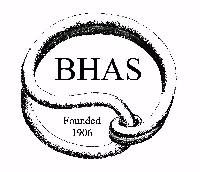Founded 1906
Archaeology Report Autumn 2018
|
Selected Article from the BHAS Bi-Annual magazine "Flint" Autumn 2018
A Magical Day on the Isle of Rousay, The Orkneys On 24th July we visited a number of sites on the island of Rousay and here I mention three of these.On arrival we walked to the magnificent Neolithic Mid-howe Chambered Tomb (Fig a), circa 3,500 BC, 32.5 metres in length and 13 metres in width. It is divided into twelve compart-ments with a passage running through and stone shelves or benches on which bodies had been laid to rest.. Today it is light and airy thanks to the purpose built metal hangar and the cat-walks which allow you to walk around and view the tomb close up. The outer wall is decorated with angular stone slabs which create a herringbone effect, per-haps a homage to the natural formation of cliffs on the islands. Maybe the tomb builders were expressing the importance of na-ture and landscape in their belief systems. This is complete conjecture on my part of course ! Just a short walk away we came to Midhowe Broch. Such brochs are Iron Age (Scottish time frame) and thought to date from 2,300 to 1,900 years ago. Midhowe stands on a naturally defensive position on a small cliff promontory and survives to about 4.3 metres and has an overall diameter of circa 18 metres. There had been an extensive complex of secondary buildings with a triple line of defence much of which is now lost to coastal erosion. The Broch lies on the north shore of Eynshallow Sound and is one of at least nine other brochs on the coastline. This was clearly an important defensive place. At the time there would have been much turbulent activity but today it is a very beautiful, serene and scenic place. We were able to sit and enjoy it for a while having our picnics. Further along the beach. we had the good fortune of seeing the ongoing excavations at Swandro (Fig b) and experience one of those rare special moments when you can look down on a site and see it just as it might have been on its final days. It is a unique Pictish smithy site and it can be seen in its original working layout as a copper workshop. The large copper anvil is thought to be in its original place and traces of the smith's knee marks were found to the left of the hearth slab in the centre of the room from 1,500 years ago. The latest piece of excitement came from the discovery, only one day old, of a handprint on the anvil. However the smith remains somewhat enigmatic at the moment. Metallurgists have discovered that a smith on this site was using copper alloy with zinc to create brass. This would have been unusual at the time of the Picts, according to the Swandro website www.swandro.co.uk so it is possible that this smithy continued to be used into the Viking period when such technology was available.
Maureen Cahalin
|


